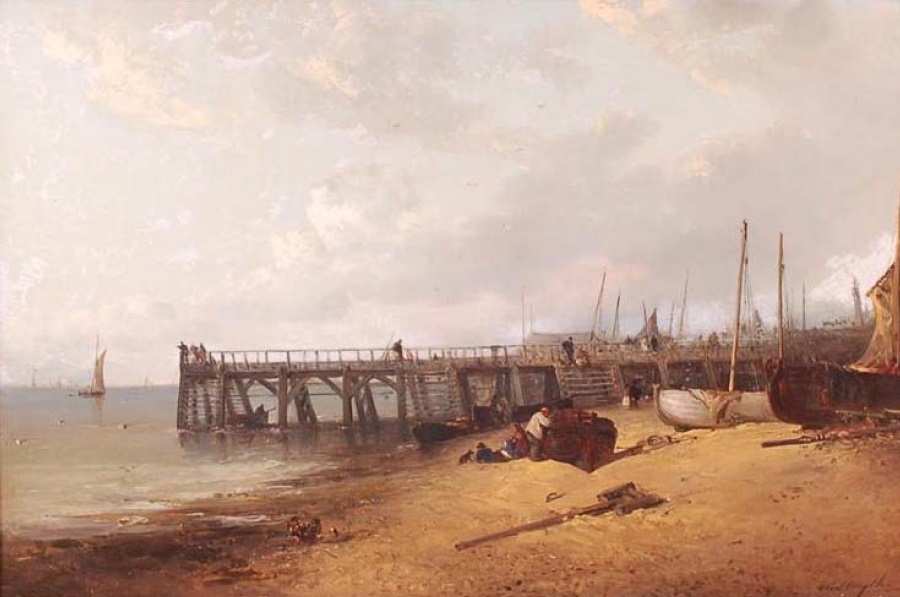Suffolk’s foremost family of artists
Bury St Edmunds auction house, Lacy Scott & Knight‘s Fine Art sale on 10th September will include three works of art by Thomas Smythe, part of the prolific family of Suffolk artists based in and around Ipswich and Bury St Edmunds. The auction house’s Fine Art Administrator, Helen Robson, tells us more about the Smythe’s work and continuing influence.
The brothers Edward Robert Smythe (1810-1899) and Thomas Smythe (1825-1907) were brought up together in Berners Street, Ipswich, by their parents Sarah Harriet née Skitter and James Smyth (the ‘e’ was added later) who was an accountant at the Bank of Bacon, Cobbold, Durningham & Cobbold in Tavern Street, Ipswich. They were educated at the school of Robert Burcham Clamp in Friars Street, Ipswich, who was probably a relative of their mother. Clamp was a member of the Ipswich Society of Professional & Amateur Artists in 1832 and probably inspired the boys interest in art. Interestingly, in the 1835 Ipswich election Clamp was involved in bribery for the Blue Conservative cause for which he spent two weeks in Newgate gaol!

Edward Robert was elected a member of the Ipswich Society of Professional and Amateur Artists in 1832 and appears to have been working under Henry Davy where he met many other local artist members. These included Robert Burrows (1810-1883), an example of whose work is also included in the September auction. He moved to Norwich around 1840 to study the Norwich School of painting where he is said to have worked with John Sell Cotman (1782-1842).
Around 1845, Edward left for Bury St Edmunds where he set up home with his new wife Ellen Bowman on Angel Hill. Meanwhile, Thomas set up on his own as a landscape and animal painter in Brook Street, Ipswich and married Jane Pearse. In 1850 both brothers exhibited several oil paintings at the Suffolk Fine Arts Association at the New Lecture Hall of the Ipswich Mechanics’ Institute.
Less known is the fact that Edward and Thomas had a sister Emma Smythe (1819 – 1877) who was also an artist. She married Robinson Taylor (1806-1864), editor of the ‘Ipswich Journal’ in 1853, and by 1861 they and their two young children were living at 196 Woodbridge Road, Ipswich. After her husband’s death in 1864, Emma taught drawing and painting and was herself a watercolour painter who exhibited at the Society of Painters in 1865. In the 1871 census was still living at the same address and described as ‘artist water colour painting’.
In 1865 Edward was living just down the road from our auction house at 98 Risbygate Street in Bury St Edmunds, but after his wife’s death in 1879 he moved in with his daughter Ellen Kate in Ipswich where he died in 1899, aged 88. Thomas also died in Ipswich in 1906, aged 81.
Between them the Smythe siblings had at least 12 children, several of which also took to art as a career. The most famous of which is Ernest William Smythe (1874-1950), youngest son of Thomas. But Emily Mary (1856-?), Annie Agnes (1868-1949), and Thomas Edward (1861-1881), all exhibited works of art. Tragically, Thomas’s son Thomas Edward was killed in a cycling accident aged only 19 and his works were exhibited posthumously at the Ipswich Fine Art Club in 1881.

The elder Smythes’ art beautifully captures an idealised rural vision of Suffolk, focusing on dogs, horses, cottages, farmworkers, fishermen and countryside scenes. The seasons are shown at their pastoral best – whether windmills on a snowy winters day or a cottage garden bathed in sunlight, all under those wide East Anglian skies.
The brothers Smythe’s pictures have steadily increased in value over the past 150 years. In the 1850s and 1860s, Thomas was selling his paintings for between four guineas (£4.20 in modern money) and fifteen guineas (£15.75p), sums which represented several weeks’ wages for the average Suffolk worker at the time.
Of the younger Smythes, Ernest William was the most commercially successful. He was member of Ipswich Art Club between 1895-1898 and was a regular exhibitor. By the turn of the century, he had married an Ipswich girl, Amelia Ellen Page, and moved to London. He worked as an illustrator for The Illustrated London News and was a war artist during the Boer War.
He enlisted in the Suffolk Regiment at the outbreak of WWI, but on 27 August 1916 he and his wife emigrated to the USA where he found work at Walt Disney Studios. He directed a short film Monkey Love (1917), was the set designer for the prequel to Wizard of Oz; The Land of Oz, and had 18 film credits for his animation. In 1940 he became a naturalized U.S. citizen and died ten years later in Los Angeles.
As Suffolk’s foremost family of artists, the Smythes helped to establish a typically ‘chocolate box’ view of the county. While rapid industrialisation transformed our cities and tempted young workers from the farms and into the factories, a sense of nostalgia for an idyllic rural ‘golden age’ England took hold. Despite the general trend of sneering at these prettified rural scenes through the 20th century, the Smythes popularity has continued – not least due to their technical skill and the beauty of the Suffolk landscape itself.
